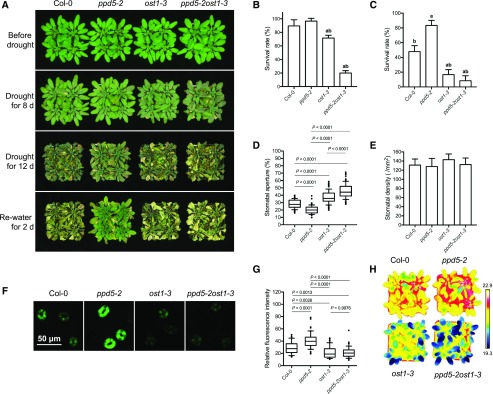Figure 5.
The ost1 mutation represses the drought-resistant phenotype of ppd5-2 mutant. A, Drought resistance assay of ppd5-2, ost1-3, ppd5-2ost1-3, and Col-0. 21-d-old plants was treated with drought stress for 8 d or 12 d and then rewatered for 2 d. B and C, The survival rate of ppd5-2, ost1-3, ppd5-2ost1-3, and Col-0 after 2 d recovery from drought stress treatment for 8 d (B) or 12 d (C). Values are means ± sd (n = 3 replicates, each replicate performing with 16 plants per line). The letters a and b above columns indicate significant difference relative to Col-0 and ppd5-2 mutant, respectively (P < 0.05, Student’s t test). D, Stomatal aperture of the middle leaves of 3-week-old ppd5-2, ost1-3, ppd5-2ost1-3, and Col-0 after drought stress treatment for 5 d (n ≥ 80). Stomatal aperture was calculated by the percentage of width/length ratio. E, Stomatal density of the middle leaves of 4-week-old ppd5-2, ost1-3, ppd5-2ost1-3, and Col-0. F, Representative images of CM-H2DCFDA staining of H2O2 in guard cell of ppd5-2, ost1-3, ppd5-2ost1-3, and Col-0 (n = 3 leaves, 30 stomata per leaf from 21-d-old plants after a 5-d drought stress treatment). G, Quantitative analysis of H2O2 levels in guard cells of ppd5-2, ost1-3, ppd5-2ost1-3, and Col-0 (n = 90). H, Leaf temperature of 21-d-old plants of ppd5-2, ost1-3, ppd5-2ost1-3, and Col-0 after drought stress treatment for 5 d.

